

06/2005
New AIA quarterly survey of residential design trends indicates strong business conditions
A strong housing market has generated favorable business conditions for architecture firms working in the residential sector. Overall, 44 percent of these firms indicated that their overall billings increased by 5 percent or more during the first quarter of 2005, while only 10 percent reported declines from the fourth quarter of 2004 of that magnitude. There are no signs of a slowdown, as more than half of firms report that inquiries for new work also increased during the first quarter of the year.
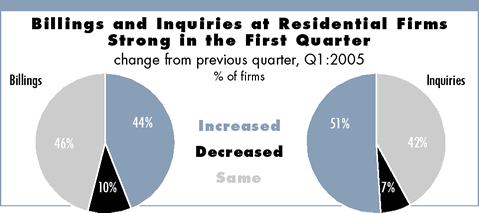
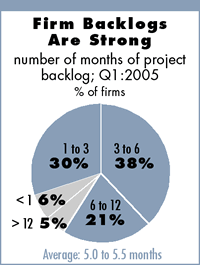 The
typical firm working in the residential sector has more than five months
of project backlogs in house. This means that without any additional
projects, the typical firm has sufficient work under contract necessary
to keep their entire staff fully employed for the next five to five and
one-half months. More than a quarter of the firms surveyed have six or
more months of work in-house. Since many residential projects have relatively
short design periods and tight schedules, these backlogs are quite significant.
The
typical firm working in the residential sector has more than five months
of project backlogs in house. This means that without any additional
projects, the typical firm has sufficient work under contract necessary
to keep their entire staff fully employed for the next five to five and
one-half months. More than a quarter of the firms surveyed have six or
more months of work in-house. Since many residential projects have relatively
short design periods and tight schedules, these backlogs are quite significant.
Remodeling
projects and condo construction strongest
Not all sectors of the residential market are performing as well as others.
About half of all firms rate the remodeling market—both additions
and alterations to existing structures and kitchen and bath remodeling—as
improving over the first quarter of 2005, with only about 5 percent
of firms reporting each of these sectors as weakening. The condominium
and town house market was equally strong, with more than half of firms
reporting improving conditions for these units.
 Move-up
homes, custom/luxury homes, and second homes/vacation
homes were rated as the reasonably strong residential sectors. Each of
these sectors had two to three times as many firms rating them as improving
as compared to the share rating them as weakening. The only sector not
showing strong improvement was the entry-level/affordable home sector,
which slightly more firms rated as weakening as rated it as improving.
Move-up
homes, custom/luxury homes, and second homes/vacation
homes were rated as the reasonably strong residential sectors. Each of
these sectors had two to three times as many firms rating them as improving
as compared to the share rating them as weakening. The only sector not
showing strong improvement was the entry-level/affordable home sector,
which slightly more firms rated as weakening as rated it as improving.
Firms in all regions report strong business conditions. However, firms in the South are particularly upbeat, with over half of firms reporting an increase during the first quarter, and only 7 percent reporting declines. Conditions at firms in the Northeast and West were similar: more than 4 in 10 firms reported improved business conditions during the first quarter and about 1 in 10 reported declines. Firms in the Midwest trailed the other regions, but still reported very positive conditions as over a third of firms reported increased billings and only 14 percent reported declines.
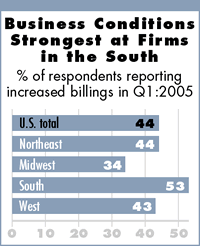 Trends feature bigger homes,
more property improvements
Trends feature bigger homes,
more property improvements
For certain segments of the housing market, smaller but better-designed
homes are growing in popularity. However, for much of residential activity, “bigger
is better” remains the watchword. More than 40 percent of firms
working on residential projects report that the square footage of homes
is still increasing, while only 13 percent report declines in the average
floor space of homes.
Some techniques to increase space in the home are showing more popularity than others. The volume of homes is increasing, as over half of firms report that ceiling heights are increasing, and that the volume of homes is growing in other ways, such as two-story entryways and vaulted ceilings. Also, almost half of firms report that finished basements and attics are increasing in popularity, often as owners of older homes are looking to increase their living space. (See graph below "Grounds Being Improved Even as Lot Sizes Shrink")
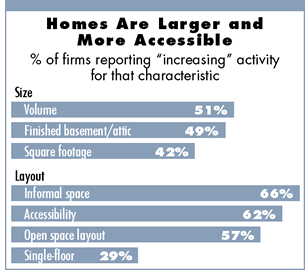 As
homes continue to increase in size on average, they also are increasingly
designed to have an open, informal feel. Two-thirds of firms report that “informal
space” (e.g. family rooms, dens, activity rooms) is increasing,
no doubt replacing formal living rooms and dining rooms. Related to this
design trend is the increased popularity of an open space layout in the
home, a growing trend according to 57 percent of firms.
As
homes continue to increase in size on average, they also are increasingly
designed to have an open, informal feel. Two-thirds of firms report that “informal
space” (e.g. family rooms, dens, activity rooms) is increasing,
no doubt replacing formal living rooms and dining rooms. Related to this
design trend is the increased popularity of an open space layout in the
home, a growing trend according to 57 percent of firms.
A majority of firms also report that homes are becoming more accessible, with features such as wider hallways, fewer steps, and other features that can accommodate an aging or less mobile population. Related to this trend is the growing popularity of single-floor design in homes to promote easier mobility. While not universal by any stretch, 29 percent of firms report growing popularity of single-floor designs, while only 16 percent report a decline in this feature.
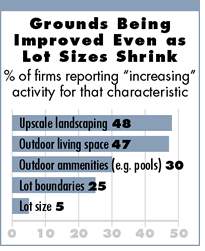 As homes are increasing their user-friendly
feel, architecture firms report that yards are being used differently,
increasingly as outdoor living space and with more improvements. Almost
half of firms report that upscale landscaping is on the increase, as
is the popularity of outdoor living space (with features such as decks,
porches, and patios). Thirty percent of firms report the increase in
other outdoor amenities, such as swimming pools, tennis courts, and
gazebos, while 17 percent of firms report a decrease in these features.
A less popular trend is providing greater emphasis on borders, such as
fencing, walls, or plantings to define lot boundaries, with 25 percent
of firms reporting increased popularity, and 8 percent reporting decreased
use.
As homes are increasing their user-friendly
feel, architecture firms report that yards are being used differently,
increasingly as outdoor living space and with more improvements. Almost
half of firms report that upscale landscaping is on the increase, as
is the popularity of outdoor living space (with features such as decks,
porches, and patios). Thirty percent of firms report the increase in
other outdoor amenities, such as swimming pools, tennis courts, and
gazebos, while 17 percent of firms report a decrease in these features.
A less popular trend is providing greater emphasis on borders, such as
fencing, walls, or plantings to define lot boundaries, with 25 percent
of firms reporting increased popularity, and 8 percent reporting decreased
use.
Even with greater emphasis on the property and more outdoor living, few architecture firms report growing lot sizes. To the contrary, only 5 percent of firms indicate that lots are increasing in size, while 43 percent report that lots are getting smaller. The remaining 52 percent indicate that lot sizes are not significantly changing in either direction.
Copyright 2005 The American Institute of Architects.
All rights reserved. Home Page ![]()
![]()
 |
||
These results mark the first AIA Home Design Trends Survey, which will be conducted quarterly with a panel of 600 architecture firms that concentrate their practice in the residential sector. Future surveys will cover special function rooms and features, emerging design trends (including design of communities, technology use, and new products), and kitchen and bath features. For information on how to participate in the next the AIA Home Design Trend Survey, send email to economics@aia.org. Download the AIA Home Design Trends Report Survey (PDF format)
|
||